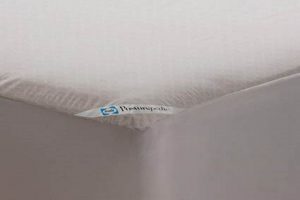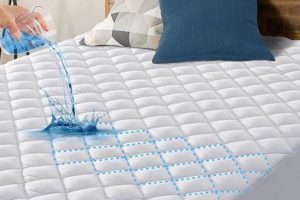A waterproof encasement designed for a standard single bed, often constructed from vinyl or polyethylene, provides a barrier against liquids, allergens, and dust mites. This type of bedding accessory is frequently used to safeguard mattresses from spills, stains, and potential damage, extending the lifespan of the sleep surface. For instance, in situations involving bedwetting or high humidity, such protection is particularly valuable.
The principal advantage lies in its ability to maintain a hygienic sleeping environment. By preventing liquids from penetrating the mattress fibers, it inhibits the growth of mold and mildew, contributing to improved air quality within the bedroom. Historically, simpler forms of mattress protection were utilized to preserve the integrity of straw or feather-filled mattresses. Modern iterations offer enhanced durability and ease of cleaning, representing a significant improvement in bedding hygiene.
The subsequent discussion will explore the various types of materials used in manufacturing this product, delve into optimal cleaning and maintenance procedures, and provide guidelines for selecting the most suitable option based on individual needs and priorities.
Guidance for Using a Waterproof Single Bedding Cover
This section provides practical advice to maximize the effectiveness and longevity of the product.
Tip 1: Ensure Proper Fit: Confirm the dimensions of the single mattress before purchase. An ill-fitting cover can compromise its protective function.
Tip 2: Regular Cleaning is Essential: Wipe down the surface frequently with a mild detergent and water to prevent buildup of dirt and allergens. Allow to air dry completely before remaking the bed.
Tip 3: Inspect for Damage: Periodically examine the product for tears or punctures. Compromised integrity reduces its ability to provide adequate protection.
Tip 4: Consider Breathable Options: While waterproof, some materials may restrict airflow. Look for versions with breathable layers to minimize heat retention and promote comfort.
Tip 5: Proper Storage is Important: When not in use, store the product in a cool, dry place away from direct sunlight to prevent degradation of the material.
Tip 6: Use a Mattress Pad: Combining a mattress pad with the plastic cover can enhance comfort and absorbency, providing an extra layer of protection against minor spills.
Tip 7: Replace When Necessary: Over time, the protective barrier may become less effective. Consider replacing the product every one to two years, or sooner if significant damage is observed.
Following these recommendations will help ensure the product provides reliable protection and contributes to a cleaner, healthier sleeping environment.
The subsequent section will address common misconceptions about the product and provide solutions to frequently encountered challenges.
1. Waterproof barrier
The “plastic mattress protector twin” fundamentally relies on its waterproof barrier to achieve its primary function: safeguarding the mattress from liquid damage. This waterproof characteristic acts as a defense against spills, bodily fluids, and other forms of moisture that can penetrate and compromise the mattress core. Without an effective waterproof barrier, the “plastic mattress protector twin” would fail in its core purpose, rendering it ineffective in preventing stains, mold growth, and bacterial proliferation within the mattress.
The selection of material for the waterproof barrier is critical in determining the overall performance and longevity of the “plastic mattress protector twin.” Materials such as vinyl or polyurethane laminates are commonly employed, each offering varying degrees of waterproofness, breathability, and durability. A higher-quality waterproof barrier will provide superior protection against liquid penetration, while also exhibiting resistance to tearing and abrasion. Failure to maintain the integrity of this barrier, through damage or wear, will compromise the protective capabilities of the product.
In summary, the waterproof barrier is an indispensable component of the “plastic mattress protector twin,” directly influencing its ability to extend the lifespan of the mattress and maintain a hygienic sleep environment. Understanding the properties and performance of the waterproof barrier is crucial for consumers to make informed purchasing decisions and ensure adequate protection against liquid damage. Challenges may arise from choosing between competing materials that offer different trade-offs between waterproofness, breathability, and cost.
2. Twin-sized dimensions
The designation “twin-sized dimensions” is integral to defining a specific category of plastic mattress protectors. These dimensions, typically 39 inches wide by 75 inches long, dictate the physical compatibility of the protector with a standard twin mattress. A protector not conforming to these measurements will either fail to adequately cover the mattress surface, leaving it vulnerable to spills and stains, or will be excessively large, resulting in a loose, ill-fitting covering that compromises comfort and protection. For instance, a protector designed for a full-sized mattress would not function effectively on a twin bed due to the significant size discrepancy.
The importance of precise twin-sized dimensions extends beyond mere physical fit. The intended user base, often children, college students in dormitories, or individuals with limited space, necessitates a product specifically tailored to the twin bed format. Manufacturers therefore prioritize adherence to these standard dimensions to ensure market acceptance and product efficacy. Deviation from these standards could result in consumer dissatisfaction and ultimately a loss of market share. The practical significance lies in the consumer’s expectation that a “twin-sized” protector will, without exception, fit a standard twin mattress.
In conclusion, the twin-sized dimensions are not merely a descriptive attribute but a defining characteristic of this specific product category. They ensure proper fit, meet the needs of a targeted consumer base, and are critical for the product’s functional effectiveness. Understanding the significance of these dimensions is essential for both manufacturers seeking to produce a viable product and consumers aiming to purchase a mattress protector that fulfills its intended purpose. The standardization of mattress sizes somewhat mitigates the challenge of finding a properly fitting protector, but consumers must still verify compatibility before purchase.
3. Material composition
The material composition of a “plastic mattress protector twin” is a critical determinant of its performance characteristics, influencing its waterproofness, durability, breathability, and overall suitability for its intended use. The selection of constituent materials dictates the protector’s ability to safeguard the mattress and maintain a hygienic sleep environment.
- Polymer Type
The foundational element is the polymer used to create the waterproof layer. Common choices include polyvinyl chloride (PVC), polyurethane (PU), and polyethylene (PE). PVC offers cost-effectiveness and high impermeability but may lack breathability. PU provides a balance of waterproofness and breathability but can be more expensive. PE is often preferred for its recyclability and lower environmental impact, though its durability may be less than PVC. For example, protectors designed for incontinence management often utilize thicker PVC for maximum liquid resistance, while those aimed at general allergen protection may opt for a PU blend.
- Barrier Thickness
The thickness of the plastic layer directly affects its ability to withstand pressure and prevent liquid penetration. Thicker materials generally offer greater protection against spills and tears but can reduce flexibility and increase noise. For instance, a thin, lightweight polyethylene protector might be suitable for occasional use or travel, whereas a thicker vinyl option is preferable for long-term protection in demanding environments. The balance between thickness and comfort is a key design consideration.
- Surface Treatment
Surface treatments can enhance the functionality of the “plastic mattress protector twin.” Antimicrobial coatings inhibit the growth of bacteria and fungi, contributing to a more hygienic sleep surface. Flame-retardant treatments enhance fire safety, while other treatments may improve stain resistance or reduce noise. An example is the application of a silver-ion coating to inhibit microbial growth, a feature often found in protectors marketed for individuals with allergies or asthma.
- Backing Layer (if applicable)
Some “plastic mattress protector twin” models include a backing layer, often made of a non-woven fabric or a knitted material. This layer provides added comfort, improves airflow, and prevents the plastic from directly contacting the mattress surface. The backing material can influence the protector’s breathability and its ability to conform to the mattress contours. For example, a protector with a cotton backing layer is likely to be more comfortable and less prone to causing heat buildup compared to a protector made solely of plastic.
Ultimately, the specific blend of materials employed in the construction of a “plastic mattress protector twin” determines its suitability for different applications and user preferences. Factors such as cost, durability, breathability, and hygiene should all be considered when evaluating the material composition of a given product. The interplay between these factors dictates the protector’s overall effectiveness in maintaining a clean, dry, and comfortable sleep environment.
4. Allergen protection
The role of “plastic mattress protector twin” in mitigating allergen exposure within the sleeping environment is a significant consideration for individuals with sensitivities. The protector acts as a barrier, preventing allergens from accumulating within the mattress fibers.
- Dust Mite Barrier
The primary function in allergen protection is the creation of an impermeable barrier against dust mites. These microscopic organisms thrive in mattresses, feeding on shed skin cells and producing allergenic waste products. The “plastic mattress protector twin” encasement prevents dust mites from colonizing the mattress, thereby reducing allergen levels. For example, individuals with dust mite allergies often experience reduced symptoms when using such protectors.
- Pollen Prevention
During seasonal allergy periods, pollen can infiltrate the home and accumulate in bedding. A “plastic mattress protector twin” can minimize pollen deposition within the mattress, providing a less allergenic sleep surface. This is particularly beneficial for individuals with pollen allergies who experience nighttime symptoms. The protector can be easily wiped clean, removing surface pollen and preventing its deeper penetration.
- Mold and Mildew Resistance
By preventing moisture accumulation within the mattress, the protector inhibits the growth of mold and mildew, both potent allergens. Mold spores can trigger respiratory symptoms and exacerbate existing allergies. The non-porous nature of the “plastic mattress protector twin” prevents moisture from reaching the mattress core, thus reducing the risk of mold and mildew proliferation. Regular cleaning of the protector further minimizes the presence of these allergens.
- Pet Dander Reduction
For pet owners, dander is a significant source of allergens. While not entirely preventing pet dander from entering the sleeping area, a “plastic mattress protector twin” can minimize its absorption into the mattress fibers. This allows for easier removal of dander through regular cleaning of the protector’s surface. Individuals with pet allergies may find this particularly beneficial in managing their symptoms.
These multifaceted approaches to allergen protection highlight the value of “plastic mattress protector twin” in creating a healthier sleep environment for individuals with allergies or sensitivities. While not a complete solution, the protector serves as a crucial component in a comprehensive allergen management strategy, complementing other measures such as regular cleaning and air filtration. Selecting a protector specifically designed for allergen control, with features such as tightly woven seams and hypoallergenic materials, can further enhance its effectiveness. For example, protectors certified by asthma and allergy foundations offer assurance of their allergen-reducing capabilities.
5. Ease of cleaning
The characteristic of “ease of cleaning” is intrinsically linked to the functionality and appeal of a “plastic mattress protector twin”. The primary function of the product is to shield the mattress from contaminants. Therefore, its ability to be readily cleaned directly impacts its efficacy and hygiene maintenance. A protector that is difficult to clean would negate its protective advantages, as accumulated spills and allergens would remain, potentially fostering bacterial growth and compromising the sleep environment. For example, a protector requiring specialized cleaning agents or prolonged drying times would be less desirable than one that can be quickly wiped down with common household cleaners.
The inherent material properties of plastic contribute significantly to the ease with which these protectors can be cleaned. The non-porous surface prevents liquids and other substances from being absorbed, allowing for simple removal with a damp cloth or sponge. This is particularly important in environments prone to spills, such as children’s rooms or healthcare settings. A protector with a textured or uneven surface, conversely, would present challenges in cleaning, as contaminants could become trapped in crevices. Furthermore, the ability to disinfect the protector with appropriate cleaning solutions is crucial for maintaining sanitary conditions, especially in cases involving bodily fluids or potential pathogens.
In summary, the “ease of cleaning” is not merely a convenient attribute but a fundamental requirement for a “plastic mattress protector twin” to effectively serve its intended purpose. The smooth, non-absorbent nature of plastic facilitates quick and efficient cleaning, contributing to a hygienic and healthy sleep environment. Choosing a protector with this characteristic ensures that the benefits of mattress protection are realized without creating additional burdens in terms of maintenance. The challenge lies in balancing the protective qualities of the plastic with other desirable attributes, such as breathability and comfort, while maintaining ease of cleaning.
6. Durability
Durability is a critical attribute of a plastic mattress protector twin, directly affecting its lifespan and the level of protection it provides. A lack of durability renders the protector ineffective over time, negating its purpose of safeguarding the mattress from spills, stains, and allergens. The material’s resistance to tearing, puncture, and degradation from repeated use and cleaning directly impacts its ability to maintain a waterproof and allergen-proof barrier. For instance, a thin, low-quality plastic protector may easily tear under normal use, exposing the mattress to potential damage. Conversely, a more robust protector constructed from thicker, reinforced plastic offers greater resistance to wear and tear, extending its useful life and ensuring continued protection.
The significance of durability is further underscored by the environments in which these protectors are commonly used. In settings such as hospitals, daycare centers, or homes with young children, the protectors are subjected to frequent use and cleaning, increasing the likelihood of wear and tear. Protectors that are not sufficiently durable may require frequent replacement, leading to increased costs and potential disruptions. Consider a scenario in a nursing home where a low-durability protector fails prematurely, resulting in mattress contamination and necessitating costly mattress replacement and increased sanitation efforts. A durable protector, designed to withstand the rigors of such environments, offers a more cost-effective and hygienic solution in the long term.
In conclusion, durability is an essential component of a functional plastic mattress protector twin. It directly influences the protector’s lifespan, its effectiveness in safeguarding the mattress, and its overall value proposition. While factors such as cost and comfort are also important considerations, prioritizing durability ensures long-term protection and minimizes the need for frequent replacement. Understanding the relationship between material composition, construction, and durability allows for informed purchasing decisions that balance cost-effectiveness with long-term performance, meeting the demands of its intended applications and protecting mattresses for extended periods. A potential challenge involves accurately assessing durability claims, as manufacturers’ specifications may not always reflect real-world performance.
Frequently Asked Questions
This section addresses common inquiries and concerns regarding the utilization and maintenance of the product, offering clarification based on established knowledge and best practices.
Question 1: What is the expected lifespan of a plastic mattress protector twin?
The longevity of the product varies depending on material composition, usage frequency, and maintenance practices. Under typical conditions, a protector constructed from durable materials such as vinyl can provide effective protection for one to two years. Regular inspection for damage and prompt repair or replacement is recommended to maintain optimal performance.
Question 2: Can a plastic mattress protector twin be machine washed and dried?
Most protectors are not designed for machine washing or drying. The heat and agitation can damage the plastic, compromising its waterproof properties. Cleaning typically involves wiping down the surface with a damp cloth and mild detergent. Refer to the manufacturer’s instructions for specific cleaning recommendations.
Question 3: Does a plastic mattress protector twin create excessive noise during sleep?
Some materials, particularly inexpensive vinyl, can produce a crinkling sound when the sleeper moves. Selecting protectors made from softer, more pliable materials or those with a fabric backing can minimize noise. Allowing the protector to air out after unpacking can also help reduce initial stiffness and noise.
Question 4: Will a plastic mattress protector twin trap heat and cause discomfort?
Plastic is generally not breathable, which can lead to heat buildup and discomfort. Opting for protectors with breathable membranes or those incorporating fabric layers can improve airflow and reduce heat retention. Using breathable bedding materials, such as cotton sheets, can also help mitigate this issue.
Question 5: Are all plastic mattress protector twin products hypoallergenic?
While the plastic barrier inherently prevents dust mites and other allergens from penetrating the mattress, not all protectors are specifically designed with hypoallergenic materials. Look for products labeled as hypoallergenic or certified by organizations such as the Asthma and Allergy Foundation of America to ensure they are free from common allergens.
Question 6: How should a plastic mattress protector twin be stored when not in use?
Proper storage is essential to prevent damage and prolong the protector’s lifespan. It should be folded neatly and stored in a cool, dry place away from direct sunlight and extreme temperatures. Avoid placing heavy objects on top of the folded protector, as this can cause creases and potential damage.
Consistent with these insights, careful consideration of material, maintenance, and user needs allows for the successful integration of the product into the sleeping environment.
The following segment will offer a comparative analysis of readily available product variants.
plastic mattress protector twin
This examination of “plastic mattress protector twin” has highlighted its core functionalities, material considerations, and practical applications. The analysis has emphasized its role as a barrier against liquids, allergens, and dust mites, underscoring the importance of material composition and durability in determining its overall effectiveness. Factors such as waterproofness, ease of cleaning, and compatibility with twin-sized mattresses have been presented as crucial elements in selecting an appropriate product. Additionally, common misconceptions and challenges associated with its use have been addressed, providing a comprehensive understanding of its benefits and limitations.
Ultimately, the “plastic mattress protector twin” serves as a practical tool for maintaining a hygienic sleeping environment and extending the lifespan of mattresses. Informed selection and proper maintenance remain paramount in maximizing its protective capabilities. Further research into advanced materials and manufacturing techniques may yield future improvements in breathability and comfort, further enhancing its value and user satisfaction.


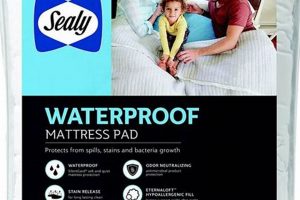
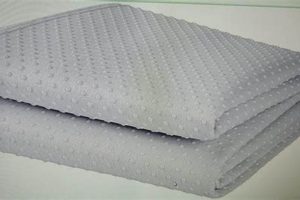
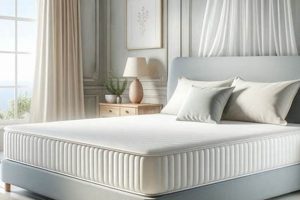
![Cool Tempur-Pedic Comfort: Cooling Mattress Protector [Guide] Organic & Natural Mattress Buyer’s Guide: Non-Toxic Sleep Solutions Cool Tempur-Pedic Comfort: Cooling Mattress Protector [Guide] | Organic & Natural Mattress Buyer’s Guide: Non-Toxic Sleep Solutions](https://mattressworldpa.com/wp-content/uploads/2025/07/th-2523-300x200.jpg)
